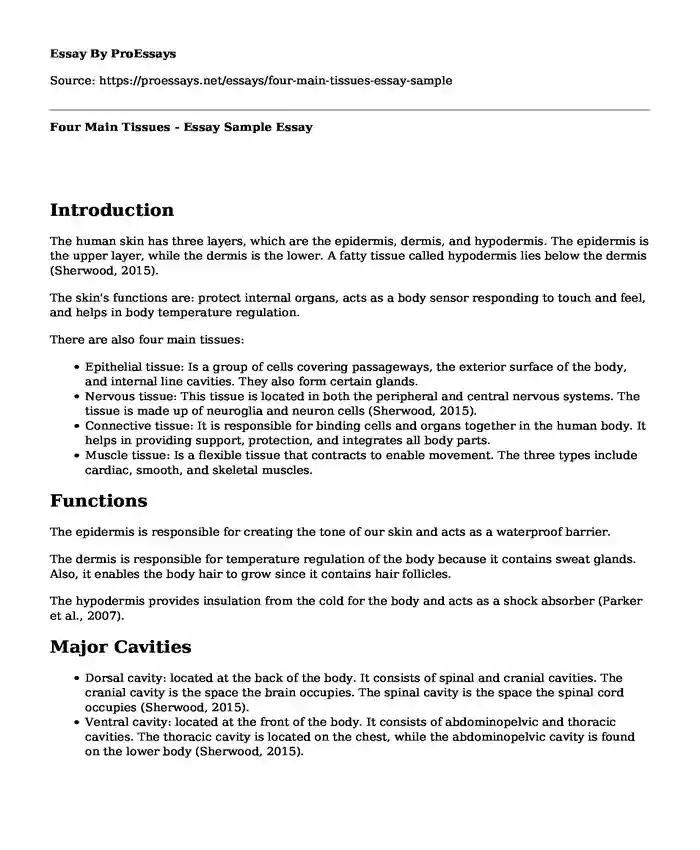Introduction
The human skin has three layers, which are the epidermis, dermis, and hypodermis. The epidermis is the upper layer, while the dermis is the lower. A fatty tissue called hypodermis lies below the dermis (Sherwood, 2015).
The skin's functions are: protect internal organs, acts as a body sensor responding to touch and feel, and helps in body temperature regulation.
There are also four main tissues:
- Epithelial tissue: Is a group of cells covering passageways, the exterior surface of the body, and internal line cavities. They also form certain glands.
- Nervous tissue: This tissue is located in both the peripheral and central nervous systems. The tissue is made up of neuroglia and neuron cells (Sherwood, 2015).
- Connective tissue: It is responsible for binding cells and organs together in the human body. It helps in providing support, protection, and integrates all body parts.
- Muscle tissue: Is a flexible tissue that contracts to enable movement. The three types include cardiac, smooth, and skeletal muscles.
Functions
The epidermis is responsible for creating the tone of our skin and acts as a waterproof barrier.
The dermis is responsible for temperature regulation of the body because it contains sweat glands. Also, it enables the body hair to grow since it contains hair follicles.
The hypodermis provides insulation from the cold for the body and acts as a shock absorber (Parker et al., 2007).
Major Cavities
- Dorsal cavity: located at the back of the body. It consists of spinal and cranial cavities. The cranial cavity is the space the brain occupies. The spinal cavity is the space the spinal cord occupies (Sherwood, 2015).
- Ventral cavity: located at the front of the body. It consists of abdominopelvic and thoracic cavities. The thoracic cavity is located on the chest, while the abdominopelvic cavity is found on the lower body (Sherwood, 2015).
Homeostatic Feedback Mechanisms
Positive feedback happens when the product of a reaction causes an increase in that reaction. It occurs when something needs to happen fast. For example, when the skin is cut, a chemical is released by the body, resulting in platelets' activation in the blood. The release of platelets causes clotting (Sherwood, 2015).
Negative feedback happens when the product of a reaction causes a decrease in that reaction. It ensures system stabilization and maintains a steady, stable state. The best example is the regulation of body temperature (Sherwood, 2015).
Digestion
Food enters the body through the mouth and is where digestion starts. Saliva is produced to wet the food, and breakdown of the food into small pieces is done through chewing. On chewing, the food is received by the pharynx, and the esophagus carries the food to the stomach. The stomach is a sac-like organ that stores, mixes, and grinds the food. From here, food moves to the small intestine for absorption of nutrients into the blood (Sherwood, 2015). Absorption takes place on the intestine’s walls. The remaining, which is waste, moves to the colon, which is responsible for the absorption of water and processing of the waste to ease defecation (Sherwood, 2015). The anus is the last part of the digestive system allowing the waste to be removed from the body..
Conclusion
The antidiuretic hormone reduces the amount of water passed in the urine to conserve the fluid volume. Alcohol obstructs its secretion; hence less water is reabsorbed, resulting in more urination.
References
Sherwood, L. (2015). Human physiology: from cells to systems. Cengage learning.
Cite this page
Four Main Tissues - Essay Sample. (2023, Dec 12). Retrieved from https://proessays.net/essays/four-main-tissues-essay-sample
If you are the original author of this essay and no longer wish to have it published on the ProEssays website, please click below to request its removal:
- Essay Example on the Human Genome Project (HGP)
- Meilaender's Readings Review
- Photosynthesis Experiment Paper
- Animal Testing: Unethical and Inhumane Practice - Essay Sample
- Animals' Rebellion: The Dream of Old Major - Essay Sample
- Research Paper Sample on Electrolytes: Critical for Muscles, Nerves & Hydration
- Free Essay Sample: American and Iranian Views on Resource Scarcity and Conservation







